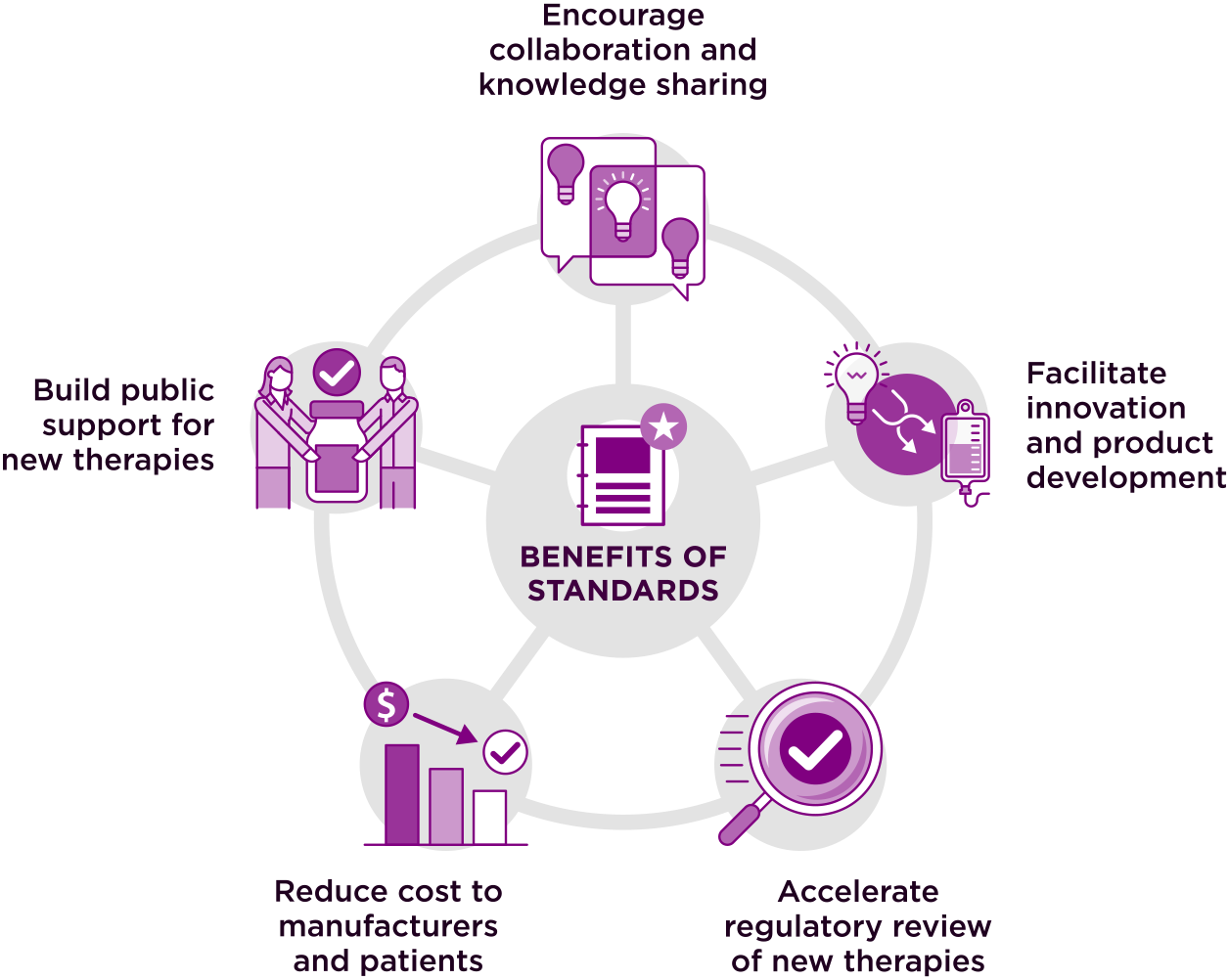Benefits of Using Standards
Take a closer look at the five major benefits of using standards, including real-world case studies and testimonials of how standards have helped industry, academia, and regulatory organizations.
5 Major Benefits of Standards
1) Encourage and facilitate collaboration and knowledge sharing
As a young industry, regenerative medicine is prone to fragmentation of knowledge, with stakeholders often working independently to solve similar problems. The standards development process:
Brings together experts from throughout the community to share pre-competitive knowledge
Makes research results more readily available to the public to drive the whole field forward
Gives stakeholders a voice in defining the standards that will best support their work
See it in action: Standard for Cryopreservation of Cells
Participating in the development of a Parenteral Drug Association (PDA) standard decision-making framework for cryopreservation processes allowed stakeholders to share knowledge about how best to ensure optimal product quality, potency, and batch-to-batch consistency for cryopreserved cell products
2) Facilitate innovation and product development
Regenerative medicine standards provide a foundation innovators can build on. This baseline of knowledge:
Reduces duplication, making more productive use of resources
Makes it easier for small businesses with limited resources to participate in product development
Sets shared targets for product quality and performance that can drive research
See it in action: Standard for Automated Counting of Colony Forming Units (CFU)
A working group developed an automated technique using a motorized stage on a microscope to capture and compile hundreds of images to allow more consistent counting and characterization of colonies derived from stem cells. Developing this standard triggered the growth of a suite of enabling technologies for the automated technique—particularly imaging software.
3) Accelerate regulatory review of new therapies
Standards assure regulators that the fundamental operations underlying a new therapy are sound, allowing them to more rapidly review a product. A smoother, less uncertain regulatory review process:
Increases industry stability, lowering perceived risk to investors
Accelerates market availability of products, increasing patient options
See it in action: Standard for Measuring Osteoinductivity of Demineralized Bone Matrices
The lack of standard methodology to assess and compare efficacy in products containing demineralized bone matrices (DBM) made it difficult for regulators to review new products. Developing a standard on this topic allowed DBM product sponsors to use the standard to document the efficacy of their products in regulatory submissions, supporting more efficient and robust product reviews.
4) Reduce cost to manufacturers and patients
Standardized equipment, methodologies, and testing protocols help industry stakeholders streamline their business processes, providing cost savings they can pass on to patients. Streamlined business processes:
Allow more efficient coordination of stakeholders from throughout the therapy supply chain, including testing laboratories and materials suppliers
Improve manufacturers’ ability to plan ahead and manage resources due to more predictable costs
See it in action: Standard Validation Framework for Rapid Microbial Testing Methods (RMTMs)
The high cost and time-consuming process of validating new RMTM systems for first-time use has prevented their broad adoption by cell therapy manufacturers. An ISO standard under development would provide a risk-based framework product developers can use to determine if RMTMs are effective and fit for purpose. Use of this standard would save significant time and resources for companies that would otherwise have to design their own validation processes.
5) Build public support for new therapies
The presence of a standard sends a signal of legitimacy that resonates with patients, regulators, and those considering investing in the industry. Standards can help:
Assure patients that products reflect researched best practices
Provide patients with confidence in the quality and safety of products
See it in action: Reference Material for Human Adenovirus 5
In 1999, a patient died due to a severe immune response during a gene therapy trial that used an adenoviral vector. At the time, no reference material existed for adenoviral vectors to help regulators to adequately evaluate the safety of viral vector submissions. Development of an adenovirus 5 reference material helped to address this major safety concern and was critical to helping restore public confidence and supporting the continued growth of the gene therapy field.
Case Studies: Benefits of Using Standards
1) Industry: Claudia Zylberberg, Founder and Executive Chair, Akron Biotech
[ video transcript ]
Key Takeaways:
As a manufacturer of ancillary materials used for regenerative medicine product development, Akron Biotech uses standards to improve their own products and to help their customers who manufacture regenerative medicine products satisfy regulatory requirements.
Regenerative medicine product manufacturing processes present novel challenges compared to existing biologics; new standards can ensure that these processes are carried out in a compliant and consistent manner.
Standards build a shared language and understanding among all the stakeholders involved in industry that can help manufacturers align with regulatory expectations and encourage the growth of the field.
Developing standards brings stakeholders from across industry together in a valuable conversation about the common practices they will all agree to follow.
Outreach is critical: It is important to include as many stakeholders as possible in the creation of standards and to help them understand their value.
2) Academia: Krishnendu Roy, Robert A. Milton Chair—Parker H. Petit Institute for Bioengineering and Biosciences, Georgia Tech
[ video transcript ]
Key Takeaways:
Since the development of the ISO 20391 cell counting standard led by NIST (Part 1, Part 2), the regenerative medicine field has seen an increase in active standards development and implementation, which is helping to accelerate the progress of the field.
It is important for academic research labs to implement standardized assays, analytical tools, methods, and protocols. These can help undergraduate and graduate students to understand how to increase reproducibility and comparability of results from lab to lab and ease translation of research.
Krish Roy is involved in the development of the SCB-coordinated, in-progress ISO 24190 standard on a risk-based framework for validation of microbial testing methods, which will be critical to making microbial detection faster, cheaper, and more accurate.
Standards are fundamental to the progress of industries—for example, standards allow cell phones to seamlessly transition from one network to another during international travel.
Standards ensure that data can move between institutions while remaining trustworthy, comparable, and reproducible.
Standards foster the growth of the regenerative medicine industry by enabling the development of reliable and reproducible products; bringing standards to the academic domain will be critical for that progress.
3) Regulatory: Judy Arcidiacono, Regulatory Scientist, U.S. Food and Drug Administration
[ video transcript ]
Key Takeaways:
Judy Arcidiacono leads the standards program for regenerative medicine therapies, which supports the development and use of regenerative medicine standards.
Standards can benefit product developers by facilitating consistent and predictable product manufacturing and assessment.
From FDA’s perspective, standards can help streamline premarket review and facilitate market entry for safe and effective products.
Standards can help product developers overcome challenges in product testing, development of performance characteristics, testing methodologies, scientific protocols, and compliance criteria.
CBER released guidance for industry in 2019 offering recommendations on the use of standards in product development and control and describing how standards are used in CBER’s review process.
When citing standards in regulatory submissions to CBER, sponsors must fully identify the standard used and may either state that they used the standard as written or provide rationale for not following it exactly.
FDA staff participate in standards development as liaisons to SDOs, and take part in research projects that lead to the development of standards in partnership with NIST.










